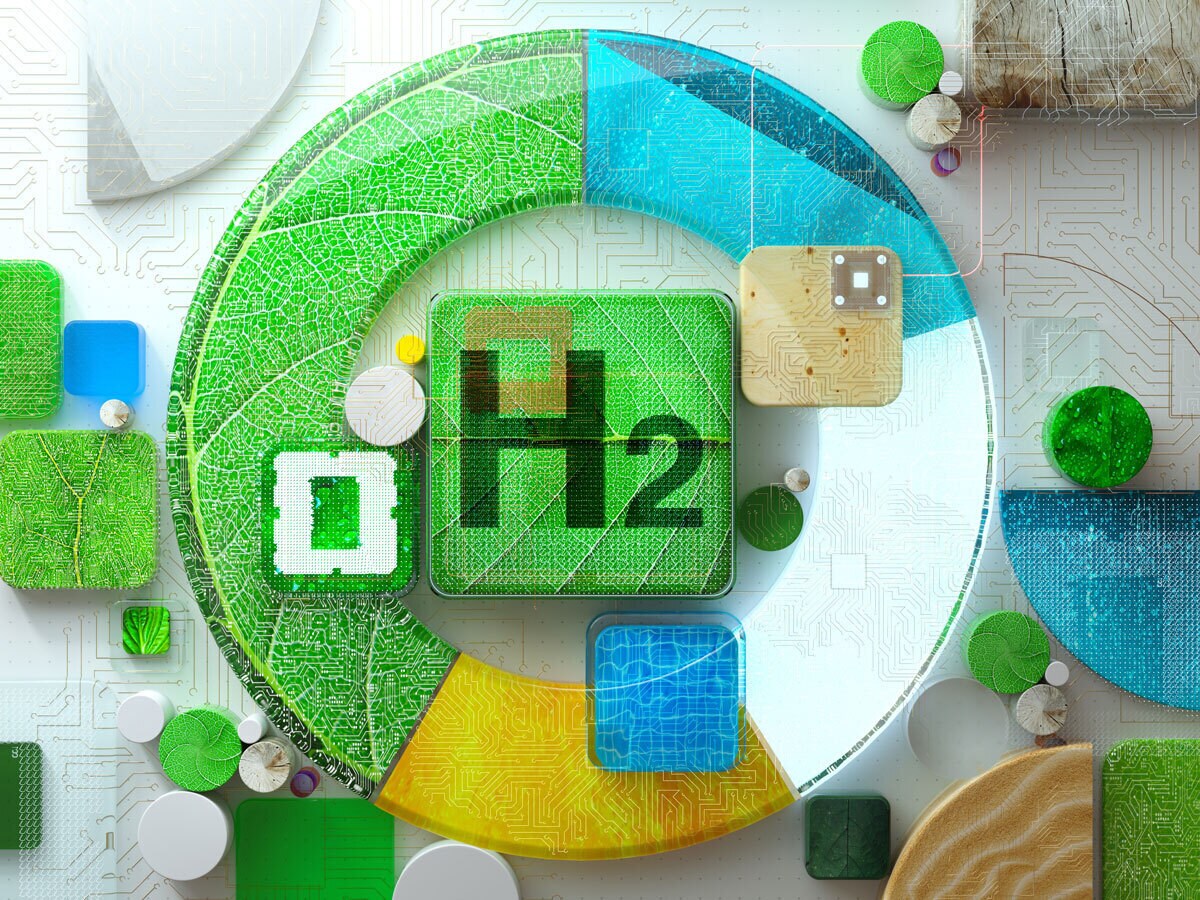Hydrogen is expected to play a big role in fuelling countries on their road to decarbonisation. While artificial intelligence (AI) should also drive the clean energy sector, the UK will need to address its skills gap.
- UK firms Ceres Power and ITM Power are key players in the hydrogen market, licensing their technologies around the world.
- The UK will need to close the skills gap if it’s to fuel its own clean energy sector.
- The HANetf iClima Global Decarbonisation Enablers ETF is up 2% year-to-date.
The transition to a net-zero economy is a $10.3trn opportunity which could be worth up to 5% of global GDP by 2050, economics advisory group Oxford Economics claimed in a report published back in January.
“As economists, we are well placed to assess the future costs implied by climate change. But we have to be honest about the fact that mitigating climate change will also be expensive,” wrote Oxford Economics CEO Adrian Cooper in the foreword to the report. Nevertheless, “a carbon-neutral global economy also presents compelling opportunities”.
The report cited clean energy equipment manufacturing, electric vehicle manufacturing, renewable power generation and renewable fuels as key drivers of the push to net zero.
Despite this, another Oxford Economics study published earlier this month found that the UK’s low-carbon power generation capacity is lagging behind other major economies. Electricity generated from renewables and nuclear in the UK is forecast to grow at a CAGR of 2.9% between 2023 and 2030. For comparison, in India and China this figure is expected to be 10.6% and 7.2%, respectively, while in the US it will be 6.4% and in Germany 6%.
If the UK is to achieve its net-zero by 2050 target, hydrogen will need to be a key driver of the clean-energy economy. The government is thus aiming to reach a capacity of 10 GW of low-carbon hydrogen production by 2030.
Key Hydrogen Players
The UK is home to world-renowned electrolyser companies like ITM Power [ITM.L] and Ceres Power [CWR.L], both of which are having major success licensing their technologies to companies around the world.
Losses at ITM widened in fiscal 2023 to £94.2m from £39.8m the year prior, according to preliminary results reported on 17 August. Revenue also slipped slightly to £5.2m from £5.6m, although this beat guidance of £2m. The company is expecting things to be brighter in fiscal 2024, however, with revenue expected to increase to between £10m and £18m.
CEO Dennis Schulz said in the release that the electrolysers being deployed at green hydrogen projects will “play a crucial role in building confidence with customers for even larger deployments in the future”.
Ceres was recently awarded the UK’s prestigious engineering award for a “ground-breaking fuel cell technology” it has developed, which “promises to make a major contribution to decarbonising the world at the scale and pace required to save the planet”, according to the Royal Academy of Engineering.
The company’s gross margin fell to 59% in 2022 from 62% in 2021 due to the delay of its Chinese joint venture with WeiChai [2338.HK] and Bosch [BOSCHLTD.NS]. Contracts will be signed this year, which should help gross margin growth to recover.
Closing the Skills Gap to Power Growth
Ceres’ high gross margin could be taken as a sign of how lucrative foreign contracts can be for the UK’s clean energy companies.
If the UK wants to ensure future investment is directed to the clean-energy and hydrogen industries on its shores, then the government needs to draw up a skills strategy. If it doesn’t, there could be an exodus of talent, Centrica [CNA.L] and the trade union GMB warned last month.
“Meeting the UK’s energy ambitions requires bold action, and we must move with urgency to create the next generation of well-paid, skilled jobs while ensuring that no worker or community is left behind on the path to a greener future,” said Centrica CEO Chris O’Shea.
A survey of energy sector workers by Engineering UK, published in July, found that only a third are confident that they’ve got the skills that will be required to adapt to the future changes in the energy industry.
AI to Help Pave the Way to a Greener Future
The UK government believes AI solutions will be key to accelerating industrial decarbonisation. Some of the skills that are likely to be needed are related to data science, and a deep understanding of machine learning and large language models.
Earlier in August, the government revealed 12 recipients that will each take a share of £1m to leverage AI to drive decarbonisation. Among them are a project to make solar-energy generation more efficient, a dairy-farming project that uses robotics to measure soil quality and health, and a project developing a more efficient computer that could potentially reduce the energy consumption of AI.
The government has pledged a further £2.25m to support the development of AI innovations designed to help cut emissions in the energy sectors specifically.
Scale Will Lower Costs and Increase Adoption
If the UK is to achieve its net-zero target, it’ll need to be generating electricity from emerging technologies such as hydrogen, wind and carbon capture as well as wind and solar power.
Green hydrogen can be transformative for the decarbonisation of heavy-duty transport, including trains and ships, and other energy-intensive industries like steel and coal, pointed out Mobeen Tahir, Research Director at WisdomTree Europe, in a blog post published in June.
“As the production of green hydrogen achieves scale, cost-reductions will foster further growth,” concluded Tahir.
How to Invest in the Carbon Transition
ETFs, or exchange-traded funds, offer an economical and diversified way to invest in a variety of stocks within a particular theme.
Funds in Focus: the HANetf iClima Global Decarbonisation Enablers ETF
The HANetf iClima Global Decarbonisation Enablers ETF [CLMA.L] holds both Ceres and ITM. The fund doesn’t provide a sector breakdown, but UK stocks accounted for 3.28% of the portfolio as of 31 July. The fund is up 2.2% year-to-date.
The Global X Clean Tech ETF [CTEC] is another that holds Ceres and ITM. The information technology (IT) sector accounts for 47.5% of the portfolio, with industrials allocated 39.6%. Materials and consumer discretionary have weightings of 7.4% and 5.5% respectively. The fund is down 17.2% year-to-date.
The L&G Hydrogen Economy UCITS ETF [HTWO.L] also holds the two companies. Industrials account for 49% of the portfolio, with materials making up 31.9%. Consumer discretionary has been allocated 10.1% and IT and utilities have weightings of 4.6% and 4.3% respectively. The fund is down 5.5% year-to-date.
Disclaimer Past performance is not a reliable indicator of future results.
CMC Markets is an execution-only service provider. The material (whether or not it states any opinions) is for general information purposes only, and does not take into account your personal circumstances or objectives. Nothing in this material is (or should be considered to be) financial, investment or other advice on which reliance should be placed. No opinion given in the material constitutes a recommendation by CMC Markets or the author that any particular investment, security, transaction or investment strategy is suitable for any specific person.
The material has not been prepared in accordance with legal requirements designed to promote the independence of investment research. Although we are not specifically prevented from dealing before providing this material, we do not seek to take advantage of the material prior to its dissemination.
CMC Markets does not endorse or offer opinion on the trading strategies used by the author. Their trading strategies do not guarantee any return and CMC Markets shall not be held responsible for any loss that you may incur, either directly or indirectly, arising from any investment based on any information contained herein.
*Tax treatment depends on individual circumstances and can change or may differ in a jurisdiction other than the UK.
Continue reading for FREE
- Includes free newsletter updates, unsubscribe anytime. Privacy policy






